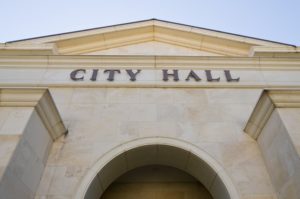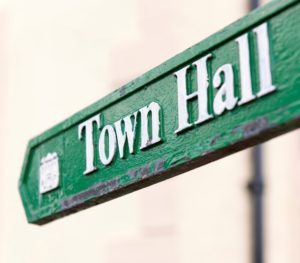What Are the Primary Functions of U.S. Local Government?
 A basic review of United States history will help you to recall the authority of federal, state, and local government functions. Specifically, the Tenth Amendment to the U.S. Constitution grants all powers not given to the federal government back to the people by way of state and local government. Citizens tend to use many of the local government departments every week without thinking about them. The federal government consists of three branches of government including the executive, legislative, and judicial departments. The U.S. Constitution doesn’t require the state governments to follow the same format, only that they hold a republican form of government. In spite of this, all states formed their state governments under the three-branch structure.
A basic review of United States history will help you to recall the authority of federal, state, and local government functions. Specifically, the Tenth Amendment to the U.S. Constitution grants all powers not given to the federal government back to the people by way of state and local government. Citizens tend to use many of the local government departments every week without thinking about them. The federal government consists of three branches of government including the executive, legislative, and judicial departments. The U.S. Constitution doesn’t require the state governments to follow the same format, only that they hold a republican form of government. In spite of this, all states formed their state governments under the three-branch structure.
According to the 2007 Census of Governments, there are 39,044 general purpose local governments across the United States that include entities such as counties, municipalities, and townships.
Most citizens engage with their local governments more often than with their state or federal governments. Concerned citizens look for assurance that their local governments are spending their tax dollars wisely for the good of the community. Local governments build trust within their communities by functioning as transparently as possible.
Local Government Structures
Most local governments divide their jurisdictions into two levels including county and municipal governments. Some states divide their county governments into townships. It’s common in New England for towns to manage the local government functions, leaving perfunctory capacity for the county level, such as census taking.
At the municipal level, the size and culture of the community play factors in labeling the government by various names such as cities, towns, villages, or boroughs. In some places, the city and county combine to form a consolidated city-county jurisdiction.
State governments have the power to make decisions about the power and authority that local governments and municipalities have. In municipal governments, the citizens directly elect their public officials.
How Local Governments Use Departments to Manage Community Functions
Local and municipal governments manage many facets of governing their communities. Communities’ infrastructures are typically divided into many departments to make their duties manageable. Typical departments that you might see in local government include:
- Police departments
- Fire departments
- Emergency Medical Services
- Libraries
- Public works departments
- Building and zoning departments
- Schools
- Parks and Recreation
- Municipal courts
- Streets and sanitation departments
- Roads and streets departments
- Public safety
- Water sanitation
- Senior citizen programs
- Cemeteries
- Housing
- Community development
- Environmental protection
Smaller communities may share some services such as libraries, schools, police, and fire departments. As needed, local governments can form additional committees and sub-committees to address various community problems or needs.
Funding for Local Governments
Every level of government has the power to tax its citizens. While citizens generally understand that it’s necessary for governments to pool their financial resources to provide local government functions to the community, most citizens keep a pulse on how much their local government spends and what they’re spending it on. It’s relatively easy for citizens to overlook the services they receive on a regular basis such as trash collection, recycling services, police protection, and more. They’re more likely to complain about services when something goes wrong.
Education tends to be one of the largest line items in local government. In many cases, education costs make up close to a quarter of a community’s budget, despite additional funding from the state government.
Property taxes on land, buildings, and personal dwellings provide much of the income for local governments. Local governments also get some of their income from licenses, fees, state-operated businesses, federal grants, state grants, and lotteries. Local governments usually have restrictions on how they can use federal grants. Local governments can use such grants for building projects, road improvements, bridges, dams, education, healthcare, and social welfare programs.
Local governments have the ability to make decisions about whether to tax items such as food, clothing, alcohol, and cigarettes.
Creating Transparency in Local Government
In many respects, citizens and local government workers are on the same page with their expectations for transparency in local government and citizen engagement. Most municipal leaders are aware of the importance of transparency as a vital component to trust and citizen engagement. Citizens seek transparency as a means for obtaining information about their local government and how it spends its money for the betterment of the community. Citizens want information that’s relevant, timely, easy to understand, and easy to get a hold of. Most local governments see the value in providing information to citizens as their input is a vital component to greater collaboration and participation. Getting clear information to citizens allows them to ask better questions, get better answers, and strengthen their connections to their communities. Getting accurate and timely information also lessens citizen’s concerns over fraud and corruption in local government.
Technology is the key to connecting the important dots between citizens and local government functions. The most natural place for citizens to seek information about what’s going on within their communities is their local government’s website.
That’s precisely why iCompass designed a software program called the Transparency Portal. This software program provides an extension of a local government’s website with the same look and feel as the main website. The Transparency Portal allows citizens access to council meeting agendas and minutes with real-time updates. iCompass also offers a Video Manager program where citizens can easily view council meetings in real-time or a recorded version of the meeting at a later time. Time-stamps make it convenient for citizens to scroll to the exact portion of the meeting that interests them in the event that they are only interested in certain issues. Video Manager also has closed-captioning capability to allow access to council meetings for disabled persons. Citizens can also retrieve information on Freedom of Information Act requests simply by creating an online search.
The Board Manager program allows private citizens to apply online for vacant positions on boards and commissions. The program provides them with updates on the progress of their application at any time of day or night.
The programs offered by iCompass bring local citizens into the loop of local government functions by providing direct access to the information they want most at the time that they need it. iCompass software solutions create a win/win partnership between local government staff, elected officials, and the citizens they serve.


